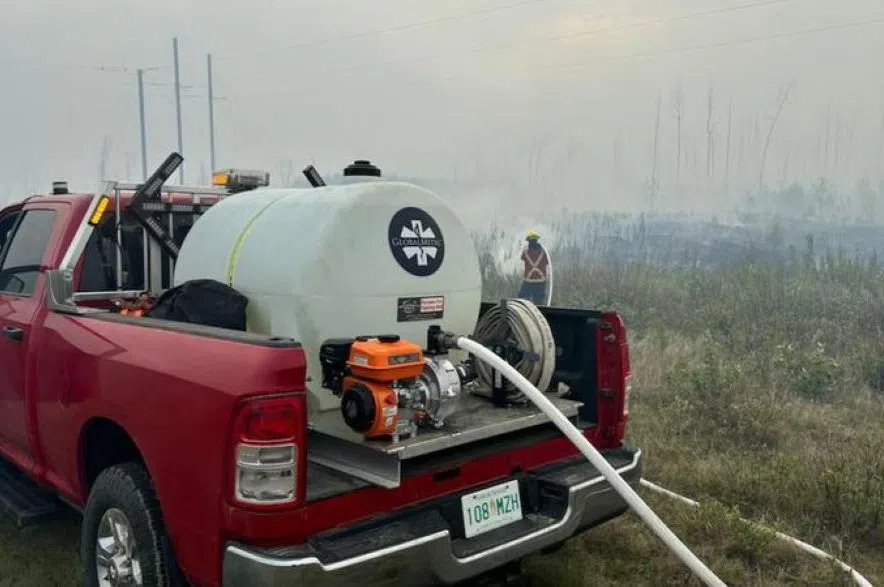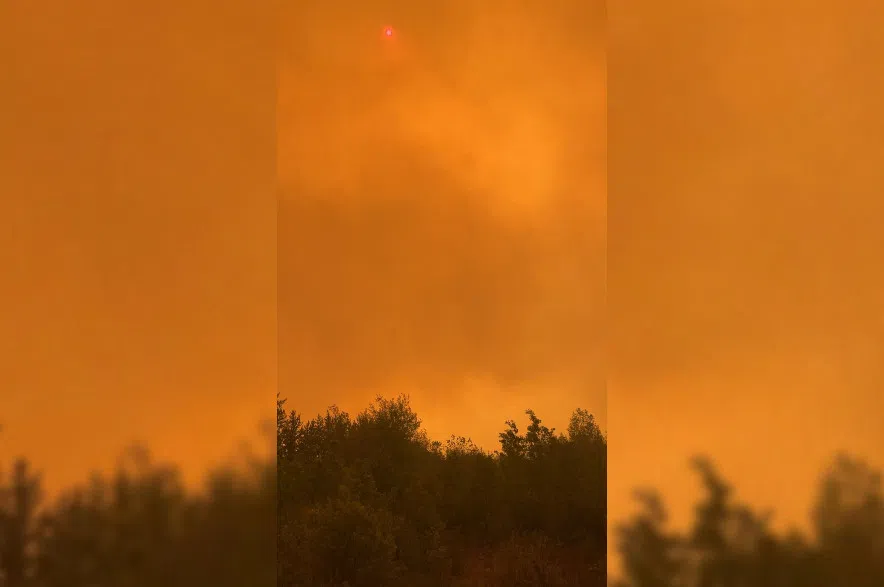An evacuation order was issued for La Ronge, Air Ronge and Lac La Ronge IR late Monday afternoon as the fast-moving Pisew Fire threatened the communities, and in an update around 6 p.m. Saskatchewan Public Safety Agency (SPSA) said the fire had breached the airport
The Pisew Fire, which SPSA said was 83,630 ha (around 20,6654 acres or roughly three and a half times the size of the city of Saskatoon), at noon on Monday had forced the evacuation of several communities in the morning, including Sucker River, Wadin Bay, English Bay and the Nemeiben Lake.
In an alert issued around 6 p.m., SPSA said people who could self evacuate must take Highway 2 and then register at the Days Inn in Prince Albert, while those needing transport should go to the JRMCC Centre in La Ronge.
SPSA also said people on buses would only be allowed to take one small bag of personal belongings with them and no pets would be allowed on buses or in shelters.
Read more:
- Hope for rain dims as northern Sask. wildfires burn
- RezCross now open on Beardy’s and Okemasis’ Cree Nation
- Donations drive begun, Métis Nation Sask. declares wildfire state of emergency
La Ronge Mayor Joe Hordyski is encouraging residents of the tri-communities to try and remain calm as they evacuate.
The total population of the communities is about 7,500. Saskatchewan Premier Scott Moe said on Saturday more than 8,000 people had been evacuated in the province.
Highway 910 near Highway 165 and Junior 913 to Highway 165 are closed, SPSA operations vice-president Steven Roberts said in a briefing early on Monday afternoon.
Roberts said if Highway 2 is compromised and they cannot guide people through that they will move towards Highway 165.
“They (evacuees) hit the 165, they will travel west and then down through Île-à-la-Crosse on that highway down through the 155.”
According to the SPSA, almost all of these roads were not impacted by fire as of Monday afternoon.
“There’s a little bit of fire adjacent to the highway at Hall Lake, and we would manage that if we needed to use that as our primary corridor for an evacuation,” Roberts said.
Its anticipated that evacuated residents from the La Ronge area will be sent to several locations such as Hudson Bay, North Battleford, Prince Albert and Weyburn.
La Ronge paramedic Nina Nahachewsky said the community isn’t a stranger to wildfires, but the threat of it still has some residents concerned.
“It’s definitely pretty smoky,” she said. “The big thing right now is just trying to stay calm, and some people are already leaving town, which will help with the bottleneck of everybody else evacuating.”
Nahachewsky said that emergency services started earlier with hospital evacuations to help those who are under a higher risk out of the community ahead of time.
“Patients who aren’t able to walk, that are just at a higher risk due to the smoke conditions.”
Nahachewsky is staying in the community to continue to help out those who are going to need it as the fires burn on.
The Saskatchewan Health Authority (SHA) said in a news release on Monday afternoon it was working to safely evacuate more than 45 acute care patients and long-term care residents from the La Ronge Health Centre and care homes in La Ronge.
The SHA statement said La Ronge Health Centre remains open for anyone who requires emergency care and as the evacuation proceeds, emergency services would be available at Prince Albert Victoria Hospital if the La Ronge Health Centre is required to close.

A member of Buckland Fire and Rescue using a wildfire skid unit to action one of the many blazes burning in northern Saskatchewan. (Buckland Fire and Rescue/Facebook)
SPSA is urging people to take a look at the Highway Hotline before any northern travel.
“We will continue with a full fire ban and ATV ban across the entire northern part of Saskatchewan to ensure no more human-caused fires are started.”

A smoke filled sky near Sucker River, a community forced to evacuate Monday due to wildfires. (La Ronge Regional Fire Dept. / Facebook)
Wildfire situation on June 2
There are currently 18 wildfires burning in the province, six of which are not contained.
The Shoe Fire (Lower Fishing Lake, Candle Lake, Smeaton) is 407,956 hectares in size. It is not contained and the Saskatchewan Public Safety Agency’s situation update noted 80 km/h winds and the possibility of thundershowers.
The fire has split into east and west divisions.
“East will burn at Little Bear Lake and Moose Horn Lodge off the guards to create a blackline around the community,” the province said.
Crews will continue to mop up at Lower Fishing Lake and feller bunchers are being used there and around East Trout Lake to take down any trees in danger of falling within one tree length of all roads.
Resources at Whelan Bay will begin fuel mitigation around cabins and there is a value protection unit working around the Minowukaw subdivision at Candle Lake. The Resort Village was expected to hold a press conference Monday afternoon to update the situation near them further.
The Jaysmith fire, northeast of Missinipe, is 38,000 hectares. Crews fighting that blaze are still working to protect the community of Brabant.

The Wolf Fire as of Monday, June 2. (submitted photo/SPSA)
The Wolf Fire is uncontained at 30,000 hectares. Resources will focus on protecting the community of Denare Beach and prepare to relocate personnel to a safe location if the community becomes no longer safe to protect.
The Club Fire, north of Creighton, is 25,000 hectares on the Saskatchewan side.
The Pelican2 Fire, northeast of Pelican Narrows, is 9,070 hectares in size. Crews continue to hotspots in and around infrastructure within the community. They continue to work on securing Highway 106 to keep it open for emergency services as well as the community of Sandy Bay for access.
Meanwhile, the Ditch02 Fire north of Weyakwin, is 15,000 hectares and causing intermittent closures of Highway 2. Resources on that fire include help from the Buckland Fire Department, Prince Albert, Wakaw, Martensville and Warman fire departments.
There are now 22 communities evacuated as a result of wildfires burning in Saskatchewan and more than 8,000 people are displaced.
Call out for more firefighters
“Our best bet for Saskatchewan is to bring them (firefighters) in from our neighbouring wildfire agencies like British Columbia, like Oregon, like Alaska, the military do not do firefighting on an ongoing basis,” said SPSA.
SPSA officials said they would bring in local crews before the military, “they are easier to support when they come from the local community.” They said if, like in 2015 — they need more help, they will then look at the military.
— with files by LarongeNow and PA Now
Read more:











